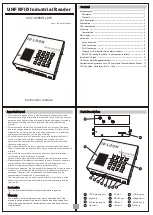
4-2
a)
A smooth, uniform cut with a total length of more than 3 inches /7.5cm in the ply.
b)
Cracks (uneven edges) in any direction that exceed 1 inch /2.5cm in the ply.
c)
Perforations having a diameter of more than 1 inch.
d)
Any damage to the ply of the tire bead. If the tire is damaged but still within the above criteria, the
tire must be inspected daily to ensure that the damage does not exceed the permissible standard.
4.1.3 Tire replacement
Our company recommends replacing the tires of the same size, grade and brand as the original tires of
the machine. Please refer to our company’s parts manual for the part number of the certified tire for a
specific machine model. If you do not use our company-certified tires, the replacement tires used should
have the following characteristics:
a)
Play/rated load and size equal or better than original tires.
b)
The tread grounding width is equal to or better than the original tire.
c)
Wheel diameter, width and compensation dimensions are equivalent to original tires.
Do not replace the foam-filled or solid-filled tire components with pneumatic tires without special
approval from our company. Ensure that all selected tires are inflated to the pressure recommended by
our company. Due to the dimensional differences between different brands of tire, the same brand
should be used for the two tires on the same axle.
4.1.4 Wheel replacement
The rims installed on each model are rigorously designed for stability requirements such as track, tire
pressure and load capacity. Unauthorized changes to the rim width, center piece position, and diameter
size without the written advice of the factory may result in an unstable hazardous situation.
4.1.5 Wheel installation
It is extremely important to use and maintain proper wheel mounting torque.
The wheel tightening nut should be mounted and held with proper torque to prevent loosening of the
wheel, damage to the stud and disengagement of the wheel from the axle. Use nuts that match the cone
angle of the wheel only. Tighten the nut to the proper torque to prevent the wheel from loosening. Use a
torque wrench to tighten the fasteners. If you do not have a torque wrench, use a socket wrench to
tighten the fasteners and then immediately ask the service station or dealer to tighten the nuts to the
correct torque. Excessive tightening will cause the stud to break or permanently deform the stud holes
on the wheel. The correct steps to tighten the wheel are as follows:
a)
Manually screw all the nuts to prevent threading. Do not use lubricant on threads or nuts.
b)
Please tighten the nuts in the following order.
Содержание ZT20J
Страница 8: ......
Страница 9: ......
Страница 17: ......
Страница 18: ......
Страница 25: ......
Страница 26: ......
Страница 43: ......
Страница 44: ......
Страница 58: ......
Страница 59: ......
Страница 83: ......
Страница 84: ......
Страница 96: ......
Страница 97: ......
Страница 105: ...7 8 Figure 7 11 Electrical Schematics Figure 1 6 Perkins engine ...
Страница 106: ...7 9 Figure 7 12 Electrical Schematics Figure 1 6 Deutz D447 engine ...
Страница 107: ...7 10 Figure 7 13 Electrical Schematics Figure 1 6 Deutz D2 9 engine ...
Страница 108: ...7 11 Figure 7 14 Electrical Schematics Figure 2 6 ...
Страница 109: ...7 12 Figure 7 14 Electrical Schematics Figure 3 6 ...
Страница 110: ...7 13 Figure 7 16 Electrical Schematics Figure 4 6 ...
Страница 111: ...7 14 Figure 7 17 Electrical Schematics Figure 5 6 ...
Страница 112: ...7 15 Figure 7 18 Electrical Schematics Figure 6 6 ...
Страница 113: ...7 16 7 5 Hydraulic Schematics Figure 7 19 Hydraulic Schematics Figure ...
















































